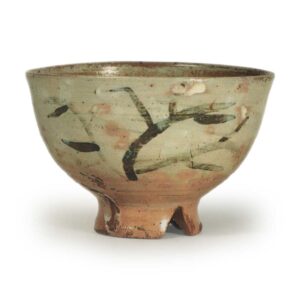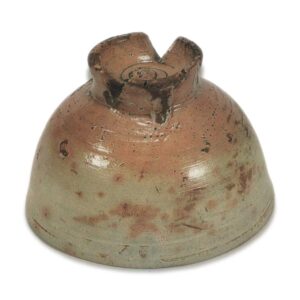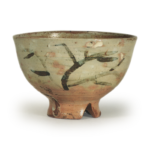

Collection: Fujita Museum of Art
Height: 8.7 – 9.0 cm
Diameter: 12.6 – 13.4 cm
Outer diameter of foot ring: 5.7 cm
Height of foot ring: 2.0 cm
The red design stands out clearly against the bluish white background, and the fact that it has a painted design means that it is considered to be a picture book. The box label simply says “Koryo tea bowl”, and the attached paper says “picture book with a split foot ring, persimmon design”, but the Fujita Art Museum’s copy says “picture book with a half-split foot ring”, and it seems that it is also called “picture hard-paste” in some places. In addition, the shape and coloring of this tea bowl are very similar to those of some Goki ware.
There is a certain logic to both of these explanations, and it may be difficult to decide which is correct, but for the time being, let’s call it a ‘picture Gohon’.
It is thought that ordinary Gohon tea bowls were made under the supervision of Japanese people at the Japanese settlement in Busan from the Kan’ei era to the Genroku era. Usually, the picture books are made on a thin, white-colored base, and simple patterns are drawn in blue-black lines on them. The shapes and patterns are rather small and intricate, and many of them are very delicate. Compared to these, this picture book is somewhat different in style.
The shape is composed with a sense of calm and composure, and the framework is solid. The gentle, relaxed curve of the wheel that spreads out from the high, arched foot is comfortable, and there is no sense of congestion anywhere. The quick lines of the wheel trace all over the foot of the vessel, and are particularly vivid in the rounding. The foot ring is a small, neatly cut triangular foot ring with two sections, and the inside of the bottom is large and round, scooped out to form a so-called scooped foot ring, with a single, clear, whorl of wheel marks centered on the helmet band. The inside is deep and wide, and near the bottom there is a crescent-shaped pattern of single characters and round sand-like marks.
On the pale blue-white base, there are beautiful red patterns of various sizes, and in particular, from the hem downwards and across the entire foot ring, the inside and outside are a fascinating pink color. There are many examples of this kind of pattern in this area. The glaze is also very clear and covers the entire surface, but the marks where the foot ring was attached and the large fingerprints that follow clearly show the dark red clay underneath. In other words, the shape and color of this piece alone are enough to make it a Koyo Goki.
What is even more remarkable is the large design painted on one side of the bowl. The iron painting, which is painted in a dark blue color under the glaze, is probably a tree, and it has a roughness and power that you would not find in ordinary paintings. The simple, uncomplicated brushwork, which is neither a trunk nor a branch, nor a leaf, is more like brushstrokes than lines, and it is this that I would call the original painting of the Yi Dynasty potters.
What is unusual here is the white speckles around the painting. This is because the clay contains certain microscopic mineral grains that become the source of the spots and holes in the glaze, but it is thought that these were covered with white slip before the painting was applied. If this is the case, it must be an extremely rare example.
From the above various points of view, this tea bowl was probably made in a kiln in the vicinity of Busan. It is thought to be of the same type as Momiji ware or similar, and is older than ordinary painted tea bowls.
The origin is unknown. There are no notable accessories other than the box inscription “Kanshin in Edo to seek Korean tea bowl”.








